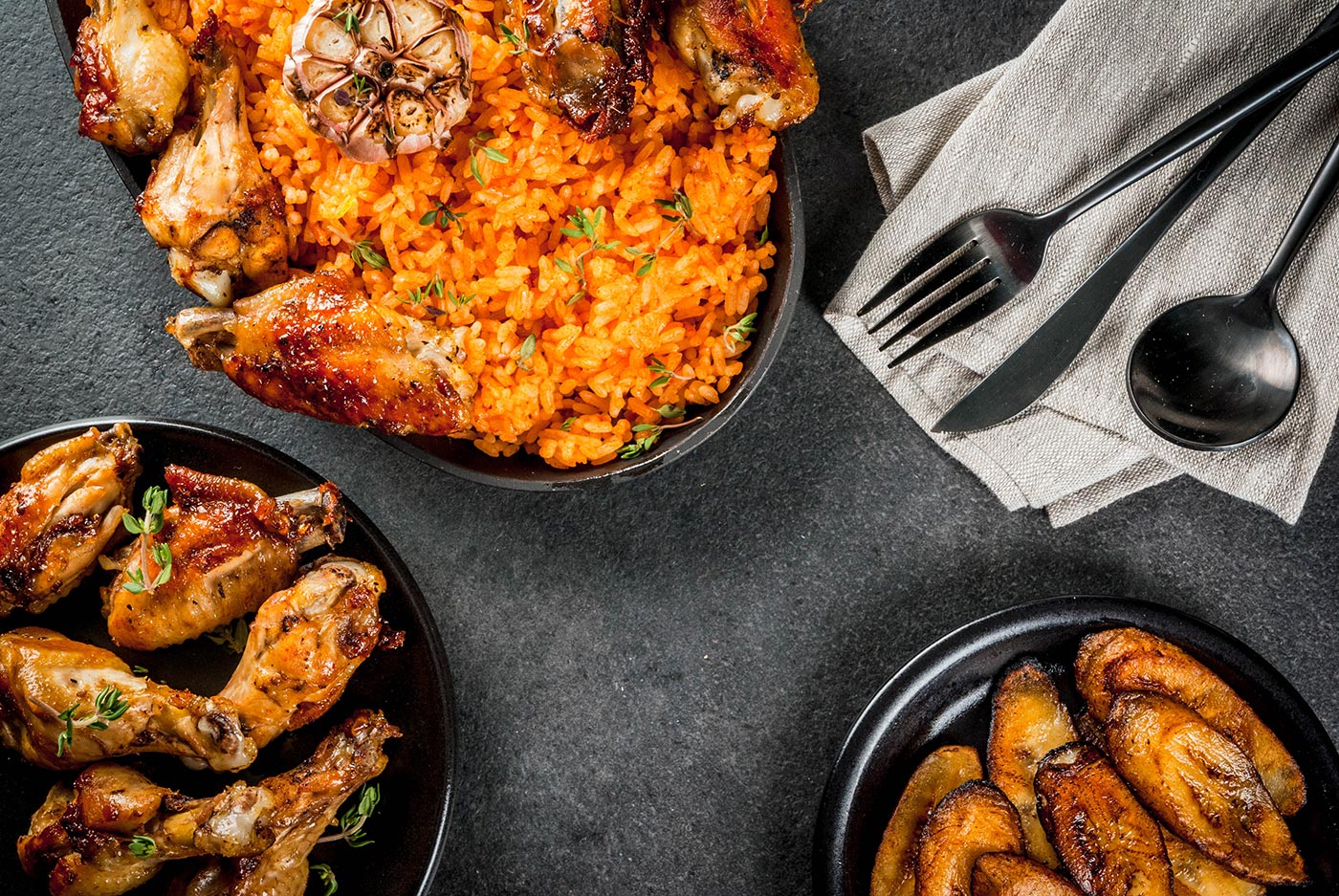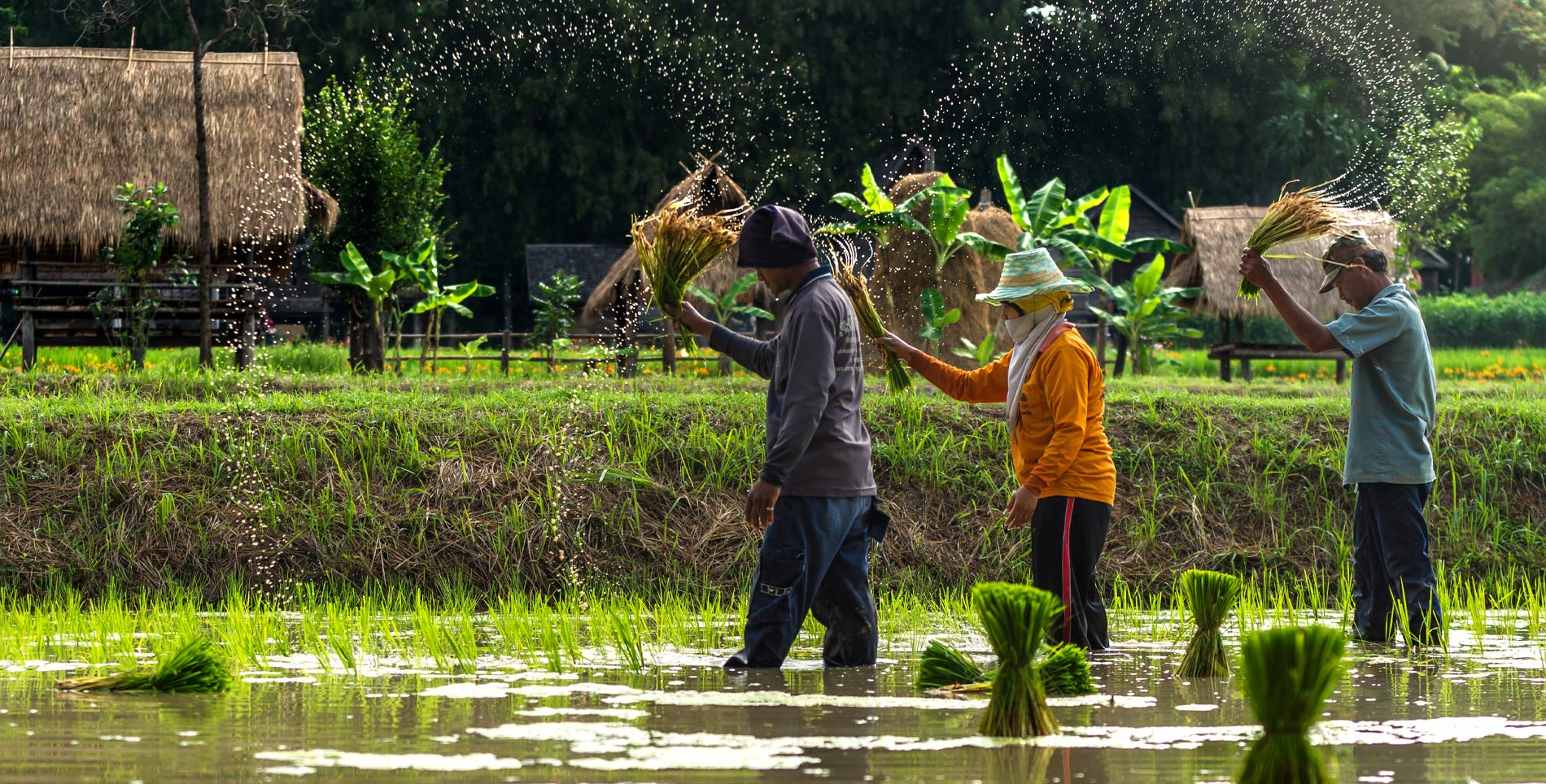Growing up, I learned to value each grain of rice. Rice was a main food item my Vietnamese refugee family turned to for both nutrition and comfort. After my parents’ long day of laboring in garment factories or in the hot sun of construction sites, the ritual of a warm, fresh bowl of rice was something my family and I enjoyed together. My sister and I would set our coffee table with newspaper, a tablecloth proxy. We each got a warm bowl of rice with a set of wooden chopsticks. Our rice would always be paired with a vegetable stir fry (cải xào), braised meat (thịt kho), or a hearty soup like stuffed bittermelon (canh khổ qua). And we ate as a family while watching the daily evening lineup of Jeopardy and Wheel of Fortune.
Rice is important to my family, along with more than 3.5 billion people worldwide—nearly half of the world’s population. In the United States, we consume around 4.22 million metric tons of rice per year. It is one of the most consumed foods in the world, yet many of us don’t know what its origin is. We might be familiar with foods as products, but not the process of how they came to be.
From Paddy To Plate: The Journey of (Broken) Rice
Every single grain of rice has an origin story. Rice is an annual grass seed. Worldwide, there are only two species of cultivated rice: African rice (Oryza glaberrima) and Asian rice (Oryza sativa). Both were developed independently from each other, and today, all the world’s domesticated rice can be traced to these two species, making up 120,000 varieties. Although the origin stories of these two species exist on separate continents, their histories are connected by narratives of survival, nourishment and colonization as Vietnamese farmers and enslaved West Africans were forced to grow export commodities like rice, indigo and cotton.
The practice of cultivating and harvesting rice has remained unchanged for thousands of years. The domestication of Asian rice dates back over 10,000 years, linked to the Austroasiatic and Hmong-Mien speaking people who resided in what is today’s southern region of the Yangtze River in present-day China. The domestication of African rice dates back over 3,500 years from the floodplains at the bend of the Niger River in what is known today as the West African country of Mali, expanding across the coast of Senegambia and Guinea Highlands.
Similar to cacao, much of the world’s rice is grown by smallholder farms (small-scale agriculture) that sell into a wholesale market, brokered by many people and companies. This means local rice farmers are constantly growing rice in exchange for the least amount of money in the food chain. For generations, rice farmers have endured this economic model in addition to volatile global politics and climate change.
Although 90% of the world’s rice is grown in Asia, other rice-growing continents include Africa and North and South America. Each region has unique environments, soil health, water availability, and even cultural rice-growing practices. The most notable image that many people have is irrigated rice, grown in flooded fields known as paddies. This method requires paddy-field farming techniques to control water levels like building terraces, canals, bunds and reservoirs. Too much or too little water or heat can wreak havoc on crops. If all things are in order, rice grass should grow to about five feet and reach maturity after three to six months. Rice is ready when the grain moisture content level is at about 25%.
At this stage, this ready-for-harvest unmilled rice is called “paddy.” In order to harvest the paddy, farmers must drain fields before cutting each plant. It takes at least 40 to 80 hours per hectare (2.47 acres) to hand-cut and bundle stalks. From here, the paddy must be dried and processed. From paddy to plate, rice grains are threshed (separate from the straw) and winnowed (remove hard protective matter, known as chaff), which is when milling can begin. In this latter step, the husk and bran layers can be removed, which turns brown rice into white rice.
Along this food journey, pieces of rice commonly break off during processing. “Broken rice” is not defective, it just has less value at retail. Whole rice is regarded as the primary product for sale and broken rice is considered secondary and less desirable. Also called brewers’ rice, broken rice is often used in food industries for beer-making, pet food, and cosmetic manufacturing. This is just one narrative and value for broken rice. In fact, historically and culturally, while broken rice has been devalued by capitalism, it has been instrumental in the survival of poor and enslaved farmworkers around the world.
Southern Broken Rice
Broken rice in the American South is known as “rice grits” or “middlins” and was introduced to the region by way of enslaved West Africans. Thousands of years before transatlantic slavery, West Africans cultivated rice as a subsistence crop, which means it was grown to primarily feed the families that grow rice. The Gullah Geechee people are descendants of enslaved West Africans who developed and worked the plantations that grew rice, indigo and cotton on the lower Atlantic Coast. Since Gullah Geechee people were enslaved on isolated island and coastal plantations, distinctive cultures emerged including foodways, language, art and music. The foundation of South Carolina today was built on this exploited knowledge and enslaved labor on Indigenous lands, including the Apalachee, Apalachicola, Catawba, Cheraw, Cherokee, Congaree, Kusso-Natchez, Lumbee, Muscogee, Pee Dee, Yamasee, Shawnee, Sissipahaw, Yuchi, Waccamaw and Waxhaw nations.

In the book Farming While Black, Leah Penniman highlights that the economies of the early American colonies in the 17th century were built on the ancestral knowledge of rice cultivation from Wolof, Mandinka, Baga, Mende and Tenne people. The first two episodes of Netflix’s High on the Hog (2021) series ground the role of rice as the intergenerational and cultural wealth of West Africans. White plantation owners purposefully enslaved Africans from rice-growing regions to cultivate rice and build the infrastructure to grow it. To clear the way for rice plantations on the Carolina coast, swamplands had to be smoothed to create suitable rice plains. The amount of dirt moved along the East Branch of the Cooper River in South Carolina is estimated to be three times the volume of Egypt’s Great Pyramid of Giza, the world’s largest pyramid.
Women played a major role in the creation of the rice economy and preserving culture among Gullah Geechee people. During the era of transatlantic slavery, West African women began braiding seeds into their hair out of survival, in case of captivity. These seeds were often used in small gardens by enslaved Africans to grow personal foods like rice and okra. It’s believed that rice from such a garden was appropriated by white colonizers to cultivate the early rice fields of South Carolina. Women made up the majority of the rice plantation labor, using a West African seed sowing technique known as “heel-and-toe.” With local materials like sweetgrass, West African enslaved women applied their cultural knowledge of coil basket making to winnow harvested rice. This process yielded broken rice, which many plantation owners did not like for commercial sales. Enslaved West Africans used broken rice to make red rice, a staple dish in Gullah Geechee cuisine that is similar to jollof rice in Nigeria, Mali and Ghana, or riz gras in Burkina Faso. Broken rice was transformed from an unwanted product to a staple that nourished Gullah Geechee people for generations, nutritionally and culturally.
Vietnamese Broken Rice
Vietnamese broken rice (cơm tấm) is a nationally famous dish. It’s typically served on a plate alongside bì heo (shredded pork skin), grilled pork chop (thịt sườn nướng), and chả trứng hấp (steamed pork-egg meatloaf). The latter two elements are items heavily influenced by French colonization. While most Vietnamese food requires chopsticks or eating with your hands, cơm tấm is one of the very few dishes served with a fork and spoon. The existence and popularity of this dish evolved from the survival of oppressed people through many local and geopolitical events, including colonization, famine, urbanization and war.

For nearly seven decades beginning in the 1880s, Vietnam, Cambodia and Laos were part of the French colonies known as Indochina. They were strategically chosen for their land and cultural knowledge of agriculture, exploited to grow export commodities like rice, tea, coffee, opium, rubber and tin. During these decades, profits were prioritized over people, as human labor and ancestral lands were being extracted by colonialism and imperialism. In fact, upward of two million Vietnamese people died of hunger during a great famine in 1945. Rice yields were drastically low as farmers were forced by the French and Japanese to grow inedible cash crops like jute (fiber), indigo (dye) and cotton. Farmers were also forced to give up what little they had to export and feed foreign military occupiers. At the same time, the United States actively targeted the warehouses and transportation routes, which destroyed major food distribution channels for local communities.
Historically, for as long as domesticated rice became a commodity, poor farmers in rice-growing regions like Vietnam turned to broken rice as a food source. It’s odd to think how those who grow food for us may not have enough to eat themselves. This is not a unique story for agriculture. Since the commercial market values whole rice grains over broken rice, rice farmers may choose to sell broken rice for less money or keep to eat. For these reasons, broken rice was stigmatized as being food for the poor.
This stigma shifted as more rural populations migrated to major cities, particularly after the end of the Vietnam War in 1975. Since moving to and existing in urban settings was often costly, many maintained their staple of broken rice to save money. While seeking new job opportunities, some turned to factory work while others began selling street food. It is here where broken rice (cơm tấm) began to appear in mainstream cuisine, representing the generational changes and political turmoil rice farmers endured.
Decolonizing and Conscious Consumerism
These few global narratives about rice demonstrate how little we actually know about where our food comes from. Food is delicious and how it grows can be a beautiful process. Yet, the history of our food is not romantic. It’s labor-intensive.
These layers of our foodways should be more visible, and it starts with us asking critical questions. Before knowing these stories, I valued every grain of rice because I valued how hard my parents worked to provide for me. Food comes from a place—from people.
Our knowledge of food may have been edited, omitted or erased from our consciousness, but that doesn’t mean their stories can’t be redeemed.







Our comments section is for members only.
Join today to gain exclusive access.